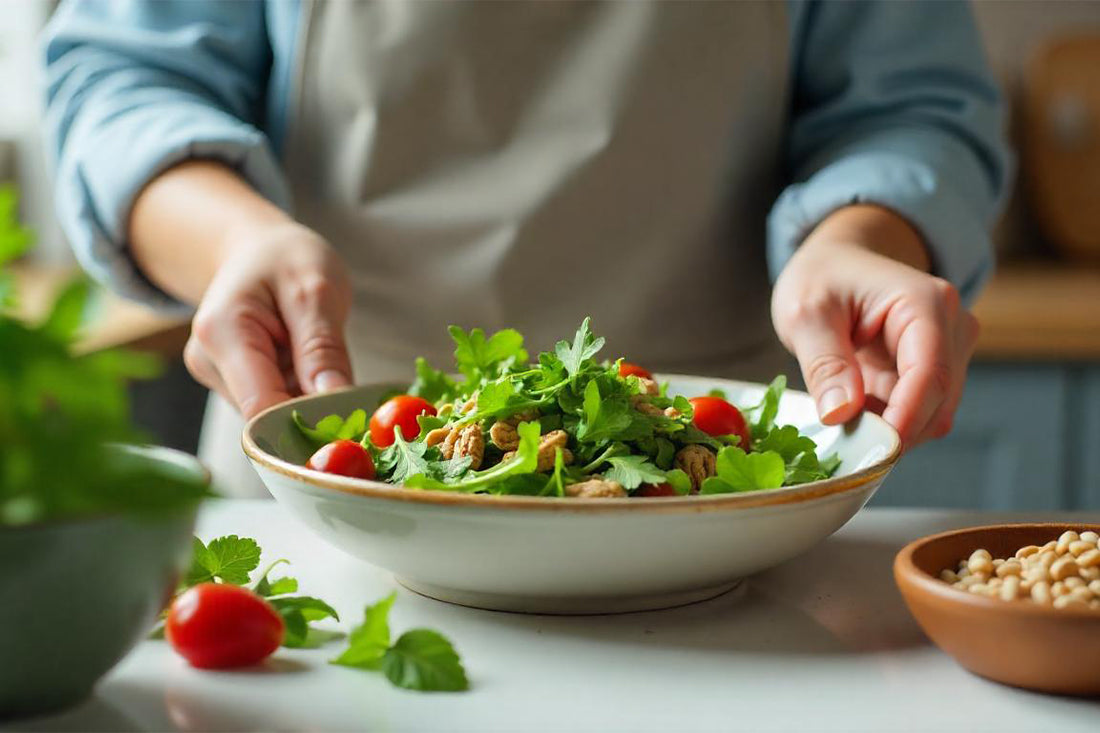You may have come across the term GLP-1 while reading about weight management, gut health, or even metabolism. But what exactly is GLP-1, and why is everyone talking about it?
GLP-1 stands for Glucagon-Like Peptide-1. It is a natural hormone made in your gut that plays an important role in how your body responds to food. GLP-1 is triggered when you eat, helping regulate appetite, support balanced blood sugar, and send signals of fullness to your brain. Some people call it the “fullness hormone” because of how it guides your body in smart ways after a meal.
The good news? Certain foods—and gut-friendly supplements—can help your body naturally support healthy GLP-1 activity. Let us explore how it works and which foods can make a difference.
What does GLP-1 do in the body?
When GLP-1 is released from the cells lining your small intestine, it helps your body by:
- Slowing the movement of food through the stomach (so you feel full longer)
- Helping your pancreas release insulin when needed
- Supporting balanced glucagon levels, a hormone that can raise circulatory glucose levels
- Sending signals to your brain to help control hunger
This makes GLP-1 a key player in supporting healthy appetite and maintaining metabolic wellness.
What Makes the Body Release GLP-1?
The body reacts to certain types of nutrients. Specifically, foods high in soluble fiber, healthy fats, and quality protein can stimulate GLP-1. These nutrients work together to support fullness, nourish gut bacteria, and help restore the body’s natural rhythm.
Which Foods Help Support GLP-1 levels?
Here are 6 foods that increase GLP-1 levels and support your body naturally through nutrition.
- Oats
Oats are a rich source of soluble fiber. This fiber ferments in the gut and creates short-chain fatty acids (SCFAs), which are known to help stimulate GLP-1. They also support satiety and can help curb cravings.
- Greek Yogurt
A source of protein and healthy fats, Greek yogurt helps support fullness. Protein-rich foods are known to trigger the release of GLP-1. Always check for no added sugars and pick plain versions when possible.
- Avocados
Avocados are packed with heart-healthy monounsaturated fats and fiber. This healthy fat-fiber combo makes it ideal for helping your body manage hunger signals while supporting GLP-1.
- Beans & Lentils
These are high in both plant-based protein and soluble fiber. When they ferment in the gut, they feed good bacteria and help create SCFAs—making them excellent for gut health and supporting GLP-1 release.
- Olive Oil
Olive oil contains healthy fats and polyphenols, which help support your body's natural response to food. Researches show that adding olive oil to meals may help trigger GLP-1, helping the brain feel fuller.
- Nuts (like almonds and walnuts)
Nuts offer a balance of protein, fiber, and fats—three key nutrients that help the gut signal satiety and manage hunger-related discomforts. A handful of nuts makes a smart, GLP-1-friendly snack.
Can Prebiotics Help with GLP-1 & Support Satiety?
While food should be the foundation, supplements can help fill in the gaps—especially if your diet lacks enough fiber.
One clean option is Sandhu’s Prebiotic Fiber Powder (Sunfiber). It contains pure, unflavored soluble fiber with no fillers—making it an easy way to support daily fiber intake. Since it nourishes gut bacteria, it may also help with the production of short-chain fatty acids that support GLP-1 release.
This powder is also gentle on the stomach and mixes easily in water or smoothies. Many users find it helpful for supporting satiety, curbing cravings, maintain regularity and helping with weight management goals. With no added sugars or artificial flavors, it fits easily into most routines.
How does Gut Bacteria Influence the GLP-1?
Yes, the gut microbiome plays a large role in how well your body produces SCFAs, which support GLP-1 activity. A healthy balance of gut bacteria can help support better digestion, reduce hunger discomforts, and help your body better signal fullness.
To support this, aim to include prebiotic-rich foods (like onions, garlic, asparagus, bananas), high-fiber supplements such as Sandhu’s prebiotic powder.
The Smart Way to Eat for GLP-1 Support:
Try to combine protein, fiber, and healthy fats in every meal. Here is a simple example of a GLP-1-friendly meal:
- Grilled salmon (protein + healthy fat)
- Quinoa and lentils (fiber + protein)
- Side of avocado or a drizzle of olive oil
Add a glass of water mixed with 1 scoop of Sandhu’s Prebiotic Fiber Powder, and your meal becomes even more supportive of gut and appetite health.
Conclusion:
Yes. Your daily food and supplement choices can help your body maintain healthy GLP-1 activity. By focusing on foods rich in soluble fiber, protein, and healthy fats, and by supporting gut health through quality prebiotic fiber, you can help your body support satiety and manage hunger cues naturally.
For anyone looking to support their weight management goals, appetite balance, and gut wellness, simple changes to the plate—plus helpful additions like Sandhu’s Prebiotic Fiber Powder (Sunfiber)—can go a long way.






